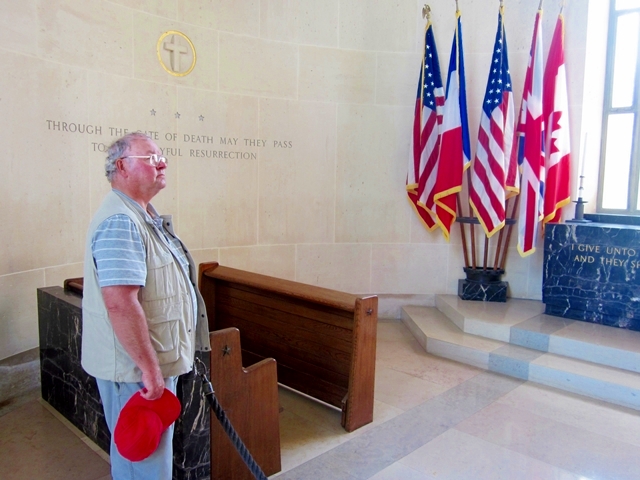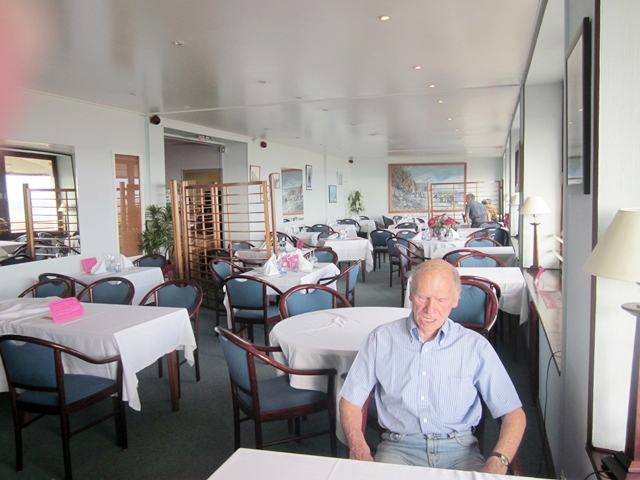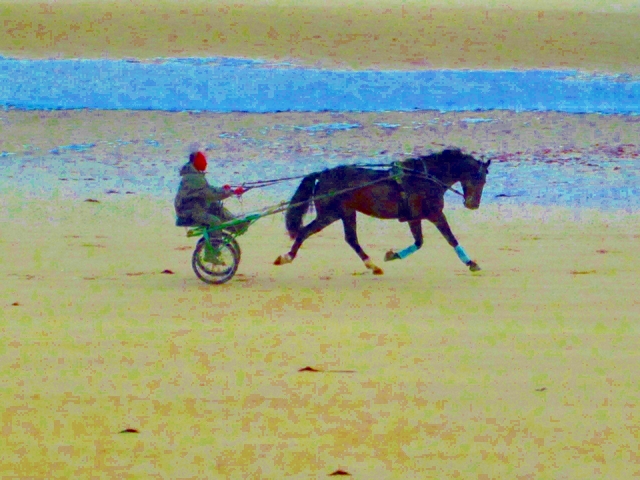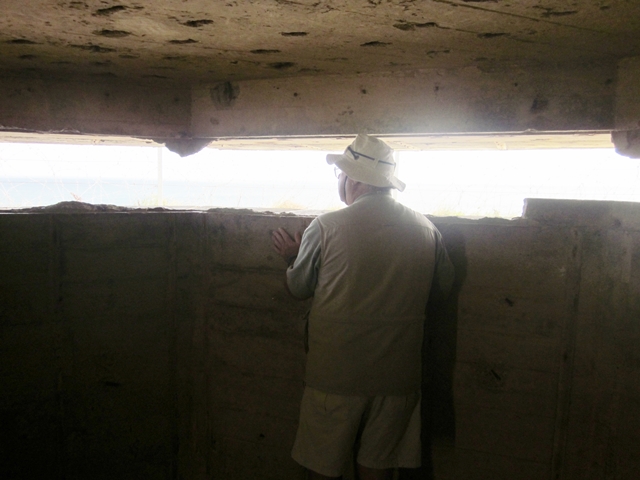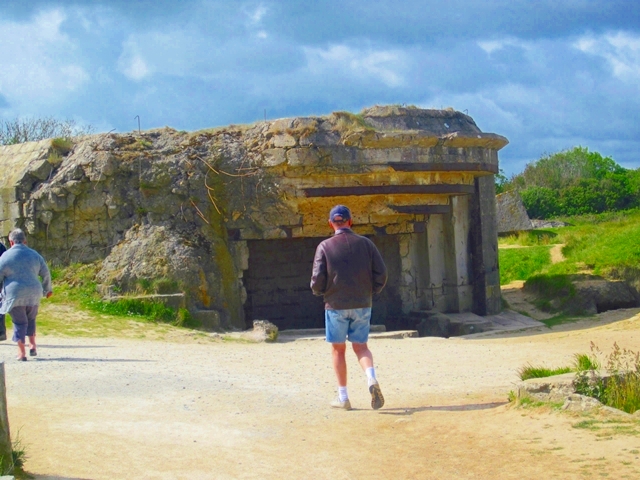The D-Day Invasion: The American Cemetery, Omaha and Utah Beaches
“Here come the Yanks”
It was getting late on Day 3, but we saw the sign for the American Cemetery and decided to have a look. We were glad we did! It was an incredible site: Over nine thousands white crosses and Star of Davids of French limestone in a beautiful and serene setting overlooking Omaha Beach.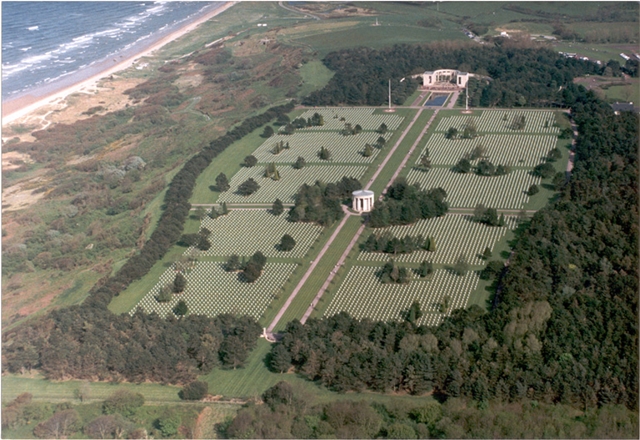 This is an aerial view of the cemetery and part of Omaha Beach.
This is an aerial view of the cemetery and part of Omaha Beach.
 This memorial consists of a semicircular colonnade with a loggia at each end containing large maps and narratives of the military operations; at the center is the bronze statue, “Spirit of American Youth.” An orientation table overlooking the beach depicts the landings in Normandy. Facing west at the memorial, one sees in the foreground the reflecting pool; beyond is the burial area with a circular chapel and, at the far end, granite statues representing the United States and France.
This memorial consists of a semicircular colonnade with a loggia at each end containing large maps and narratives of the military operations; at the center is the bronze statue, “Spirit of American Youth.” An orientation table overlooking the beach depicts the landings in Normandy. Facing west at the memorial, one sees in the foreground the reflecting pool; beyond is the burial area with a circular chapel and, at the far end, granite statues representing the United States and France.
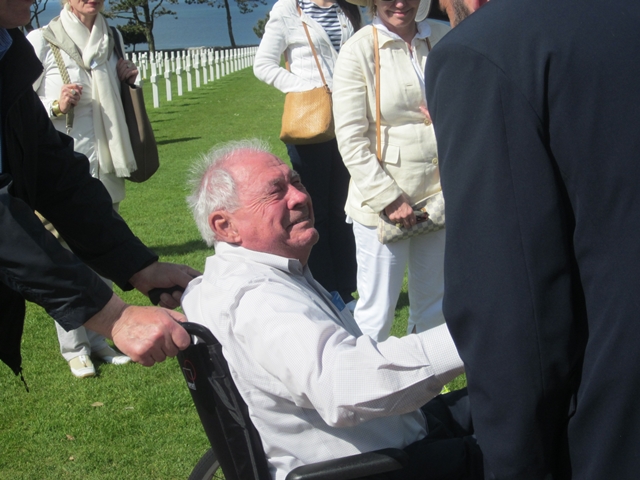 This gentleman was awaiting “Taps”. He is a veteran of D-Day and he was presented the lowered Flag. There were a lot of moist eyes there!
This gentleman was awaiting “Taps”. He is a veteran of D-Day and he was presented the lowered Flag. There were a lot of moist eyes there!
The Normandy American Cemetery and Memorial in France is located on the site of the temporary American St. Laurent Cemetery, established by the U.S. First Army on June 8, 1944 and the first American cemetery on European soil in World War II. The cemetery site covers 172.5 acres and contains the graves of 9,387 of our military dead, most of whom lost their lives in the D-Day landings and ensuing operations. On the Walls of the Missing, in a semicircular garden on the east side of the memorial, are inscribed 1,557 names. Rosettes mark the names of those since recovered and identified.
 This picture needs no caption…
This picture needs no caption…
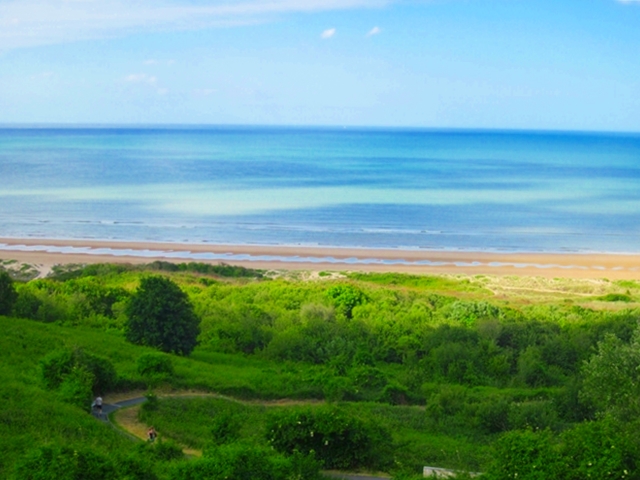 Now peaceful Omaha Beach is below the Cemetery.
Now peaceful Omaha Beach is below the Cemetery.
The Chapel in the middle of the Cemetery contained two inscriptions:
THROUGH THE GATE OF DEATH MAY THEY PASS TO THEIR JOYFUL RESURRECTION and
THINK NOT ONLY UPON THEIR PASSING REMEMBER THE GLORY OF THEIR SPIRIT
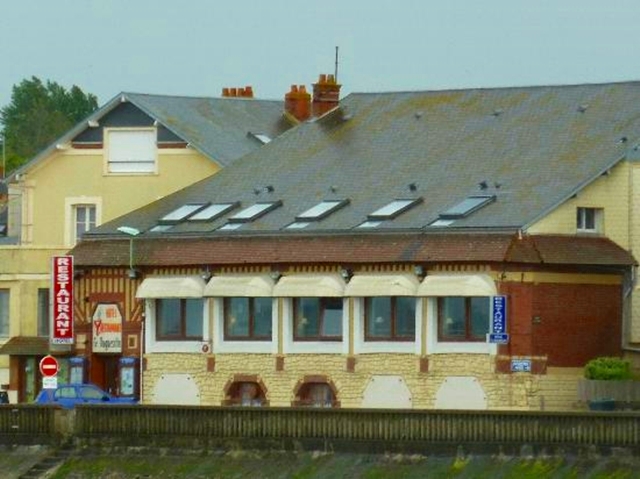 We left the American Cemetery in a somber mood and found a small hotel in Grandchamps Maisy called the “Le Duguesclin”. It was on Omaha beach that we planned to visit the next day. The room was 69 Euros (with breakfast) and another 13 for dinner (without wine). This converts to about $110.00. I had mussels in a wine sauce. They weren’t a good a Cape Cod mussels, the dessert, however was good: Flan. I forget what Archie had, but I know he had a tart for dessert…
We left the American Cemetery in a somber mood and found a small hotel in Grandchamps Maisy called the “Le Duguesclin”. It was on Omaha beach that we planned to visit the next day. The room was 69 Euros (with breakfast) and another 13 for dinner (without wine). This converts to about $110.00. I had mussels in a wine sauce. They weren’t a good a Cape Cod mussels, the dessert, however was good: Flan. I forget what Archie had, but I know he had a tart for dessert…
There is Omaha Beach, a sea wall, and a street between the water and the hotel.
 This is what you get for 69 euros. That’s Archie in bed still sleeping. (It’s now Day 4 of my visit.) Apparently I snored just a wee bit and Archie, used to sleeping in a quiet home, had a rough night.
This is what you get for 69 euros. That’s Archie in bed still sleeping. (It’s now Day 4 of my visit.) Apparently I snored just a wee bit and Archie, used to sleeping in a quiet home, had a rough night.
This is the dining room at breakfast. Although it doesn’t look like it, we ate a hearty (by French standards) breakfast of juice, croissants, coffee and jam. I showed Archie how to make a Box lunch with a baguette, and ham, cheese, and fruit. Archie liked the idea of making a lunch. He said “It was getting good value for the money.”
This is the view from the dining room window: A morning trotter going up and down Omaha Beach.
Omaha Beach was the most intensely fought after beach on D-Day on June 6th 1944. Omaha Beach was six miles wide – the largest of all the five beaches. The whole of the beach at Omaha was overlooked by cliffs which made attacking the area very difficult. The Americans were given the task of doing just that.
The Germans had built formidable defenses around Omaha. Rommel had built many of his ‘dragon’s teeth’ on the beach which were designed to take out the base of landing craft – and for good measure, the ‘teeth’ were also mined. Heavily fortified ‘resistance nests’ had been built on top of the cliffs and most German positions were connected by a system of trenches to allow for better movement of personnel. Gun emplacements had been designed to cover the beach.
The landings at Omaha is most remembered for the casualties the Americans took there. the German gun emplacements had been well placed. German machine gun fire tore into the American troops. The seawall on the beach offered some salvation – but the sprint needed across the beach to the wall proved fatal for many. This beach battle was dramatized in the “Saving Private Ryan” movie.
The only way off the beach was to scale the cliffs. Led by US Rangers, this is how the Americans escaped from the beach. Small naval craft had got as close in as they could and attacked the German gun emplacements. Their impact was important as they took away the Germans desire to solely concentrate on the Americans on the beach. By midday, German resistance was considerably lessened. By nightfall, the Americans had gained a hold on the beach and its immediate hinterland. The Americans suffered 2,400 casualties at Omaha – and this is principally why the attack is remembered. It is easy to overlook the fact that despite the casualties, 34,000 troops had been landed by the end of the day on this blooded beach.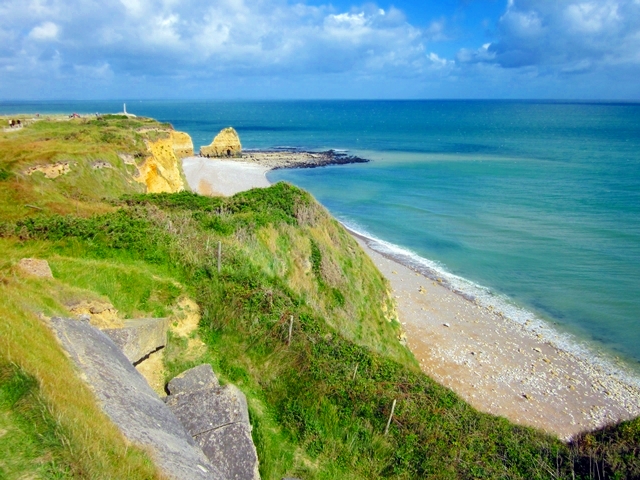 This is Omaha Beach Today. Pointe Du Hoc is in the distance. Beyond Pointe du Hoc is Utah Beach. This is where the men of the US Infantry went ashore.and these are the cliffs they had to scale.. A German gun emplacement is in the lower part of the picture.
This is Omaha Beach Today. Pointe Du Hoc is in the distance. Beyond Pointe du Hoc is Utah Beach. This is where the men of the US Infantry went ashore.and these are the cliffs they had to scale.. A German gun emplacement is in the lower part of the picture.
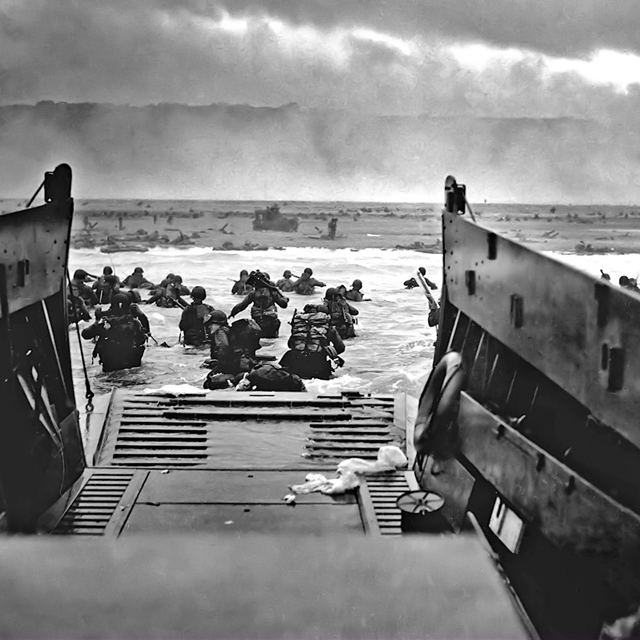 This is what the Infantry saw as they left their landing craft at Omaha Beach. Note the cliffs in the background. It was the last thing many of these men saw…
This is what the Infantry saw as they left their landing craft at Omaha Beach. Note the cliffs in the background. It was the last thing many of these men saw…
 Here is an artist’s rendering of the Omaha Beach landing. That’s an LCVP burning.
Here is an artist’s rendering of the Omaha Beach landing. That’s an LCVP burning.
The key to securing the Omaha and Utah beaches was Pointe Du Hoc. It was a nearly 100-meter-high cliff, with perpendicular sides jutting out into the Channel. It looked down on Utah Beach to the left and Omaha Beach to the right. There were six 155mm cannon in heavily reinforced concrete bunkers that were capable of hitting either beach with their big shells. On the outermost edge of the cliff, the Germans had an elaborate, well-protected outpost, where the spotters had a perfect view and could call back coordinates to the gunners at the 155s. Those guns had to be neutralized.
The 2nd Rangers were in LCA boats manned by British seamen. On June 6, 1944, D-Day, they had one of the most dangerous missions. They had to land on Omaha Beach and scramble under that heavy German machine gun fire and then scale the cliff, still under that heavy fire. Their job was to take out the big German guns at the top of the cliffs, guns that were trained on the Normandy beaches.
This is the cliff the Rangers scaled: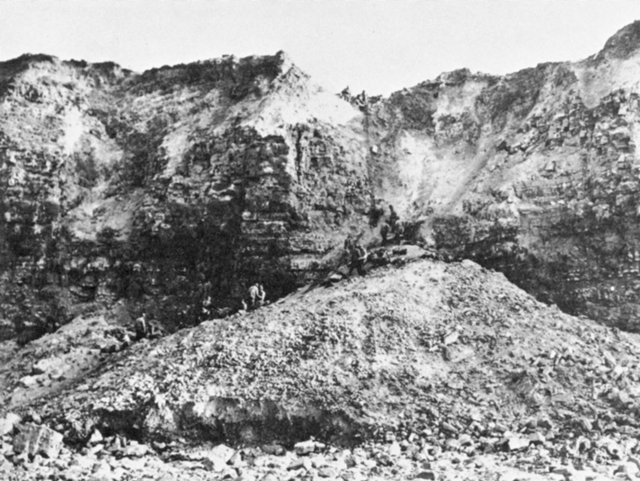 Two hundred and twenty-five US Rangers jumped off the British landing craft and ran to the bottom of these cliffs. Their mission was one of the most difficult and daring of the invasion: to climb these sheer and desolate cliffs and take out the enemy guns. The Allies had been told that some of the mightiest of these guns were here and they would be trained on the Omaha and Utah beaches to stop the Allied advance.
Two hundred and twenty-five US Rangers jumped off the British landing craft and ran to the bottom of these cliffs. Their mission was one of the most difficult and daring of the invasion: to climb these sheer and desolate cliffs and take out the enemy guns. The Allies had been told that some of the mightiest of these guns were here and they would be trained on the Omaha and Utah beaches to stop the Allied advance.
The Rangers looked up and saw the enemy soldiers—the edge of the cliffs shooting down at them with machine guns and throwing grenades. And the American Rangers began to climb. They shot rope ladders over the face of these cliffs and began to pull themselves up. When one Ranger fell, another would take his place. When one rope was cut, a Ranger would grab another and begin his climb again. They climbed, shot back, and held their footing. Soon, one by one, the Rangers pulled themselves over the top, and in seizing the firm land at the top of these cliffs, they began to seize back the continent of Europe. Two hundred and twenty-five came here. After two days of fighting, only ninety could still bear arms.
 Ths is an artist’s rendition of the Rangers assault on Ponte du Hoc:
Ths is an artist’s rendition of the Rangers assault on Ponte du Hoc:
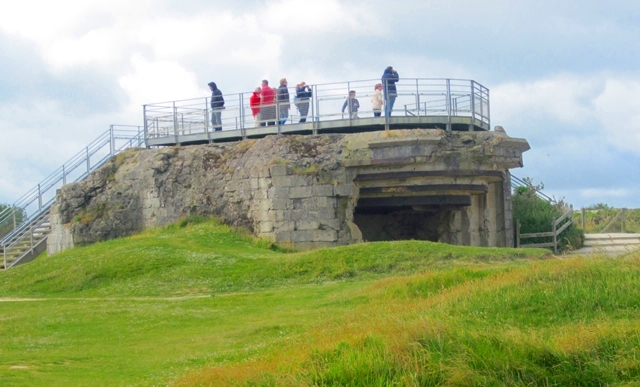 We stood on the high ground at Pointe du Hoc and looked at the German defenses.
We stood on the high ground at Pointe du Hoc and looked at the German defenses.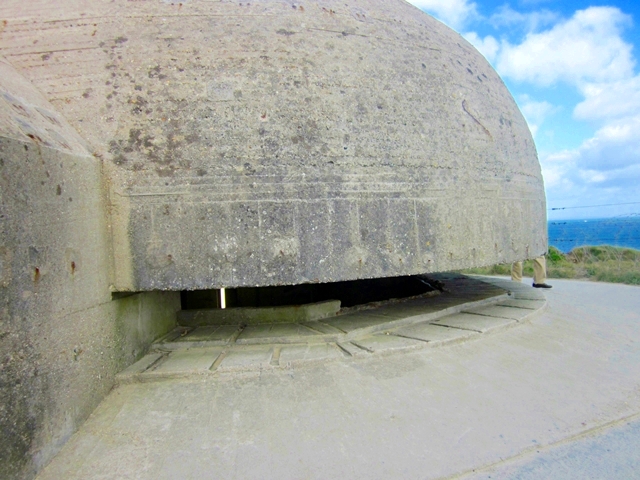
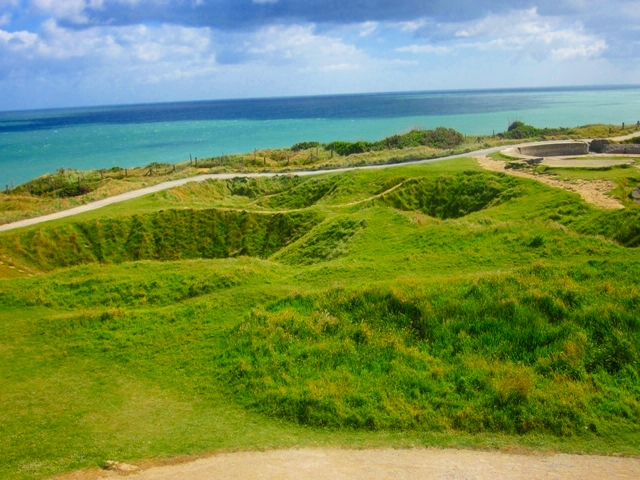 This is a very graphic shot of the craters made by US shells and bombs.
This is a very graphic shot of the craters made by US shells and bombs.
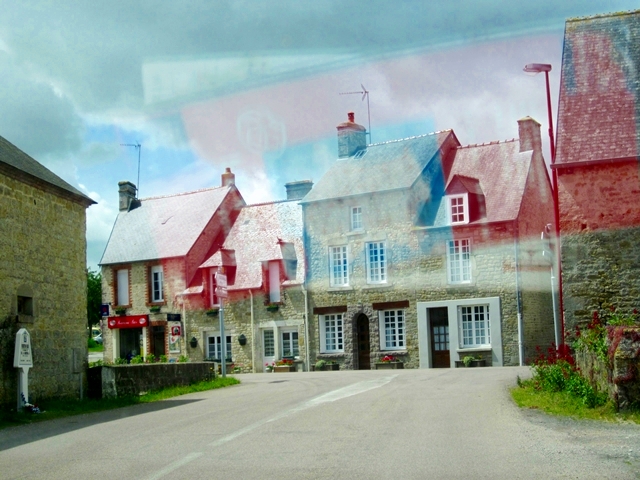
 We left Omaha Beach and headed west to the last of the D-Day Beaches: Utah. On our way, we went through several small villages. Many had chateaus. These were gated farm buildings with walls surrounding the chateau itself, barns, out buildings, and storage buildings. Tres French!
We left Omaha Beach and headed west to the last of the D-Day Beaches: Utah. On our way, we went through several small villages. Many had chateaus. These were gated farm buildings with walls surrounding the chateau itself, barns, out buildings, and storage buildings. Tres French!
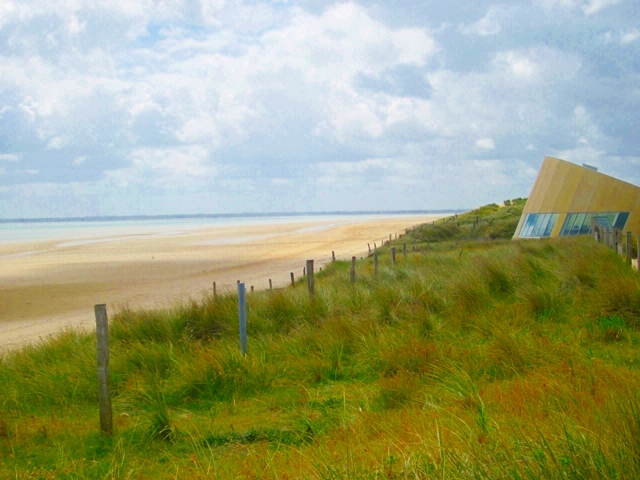 Here is Utah Beach today with a destroyed German gun emplacement.
Here is Utah Beach today with a destroyed German gun emplacement.
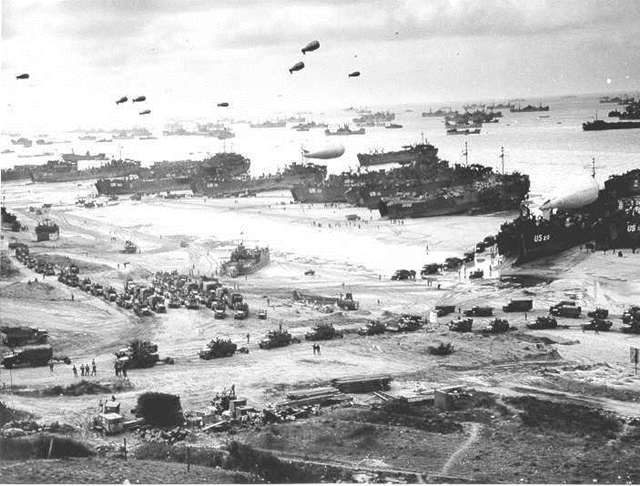 Here is what Utah Beach looked like on D-Day:
Here is what Utah Beach looked like on D-Day:
Utah Beach was the code name for the right flank, or westernmost, of the Allied landing beaches during the D-Day invasion of Normandy, as part of Operation Overlord on 6 June 1944. Utah was added to the invasion plan toward the end of the planning stages, when more landing craft became available.
Utah Beach, about 3 miles (5 km) long,. Despite being substantially off course, the US 4th Infantry Division (part of VII Corps) landed with relatively little resistance, in stark contrast to Omaha Beach, where the fighting was fierce.
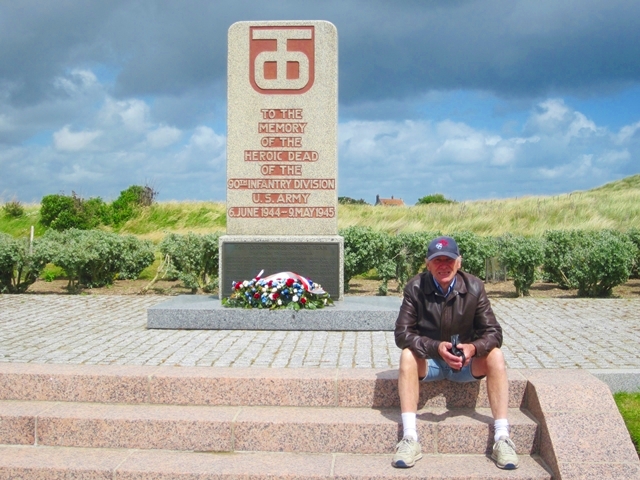 The 90th Infantry Division “Tough ‘Ombres” landed here on Utah Beach. Do you think the guy sitting there is one of them?
The 90th Infantry Division “Tough ‘Ombres” landed here on Utah Beach. Do you think the guy sitting there is one of them?
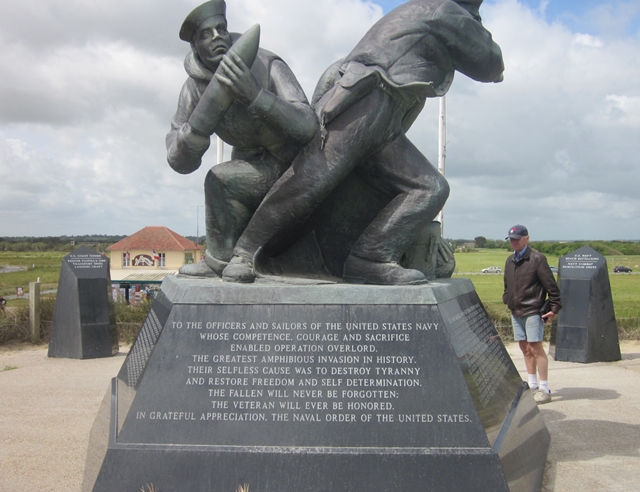 Here is a US Navy Memorial on Utah Beach. It memorializes the Navy Destroyer ships and crews that supported the landings on both Omaha and Utah beaches. This sailor is handling a 5 inch projectile. A common shell size on WWII Destroyers.
Here is a US Navy Memorial on Utah Beach. It memorializes the Navy Destroyer ships and crews that supported the landings on both Omaha and Utah beaches. This sailor is handling a 5 inch projectile. A common shell size on WWII Destroyers.
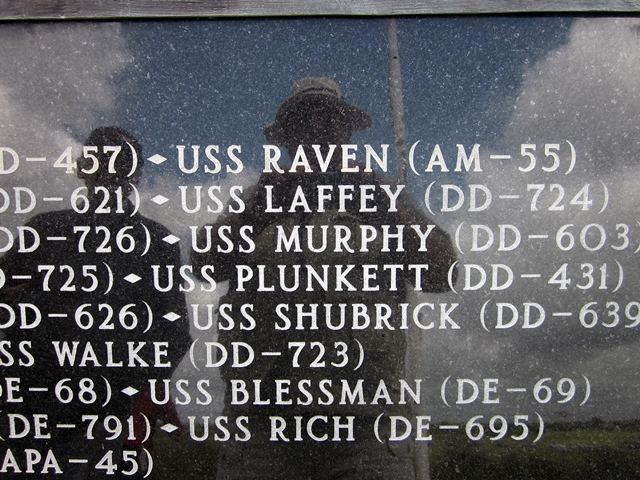 One of the Destroyers in action on D-Day was the USS Laffey DD-724. This WWII Destroyer is now a museum ship moored in Baton Rough, LA. One of the few WWII Destroyers still floating.
One of the Destroyers in action on D-Day was the USS Laffey DD-724. This WWII Destroyer is now a museum ship moored in Baton Rough, LA. One of the few WWII Destroyers still floating.
I an a member of “The Tin Can Sailors Association” and have been on board the Laffey several times. It;s a neat, well preserved ship!
We left Utah Beach and headed for Ste Mere Eglise. This is the town near Utah Beach where the US Paratroopers landed.
The Germans took St Mere Eglise on June 18th 1940 and the next four years passed relatively peacefully, soldiers were billeted in the town and a swastika flew over the town hall. During 1943 the number and quality of the occupying troops decreased. By the time of D-day the town was occupied by Austrian anti aircraft gunners.

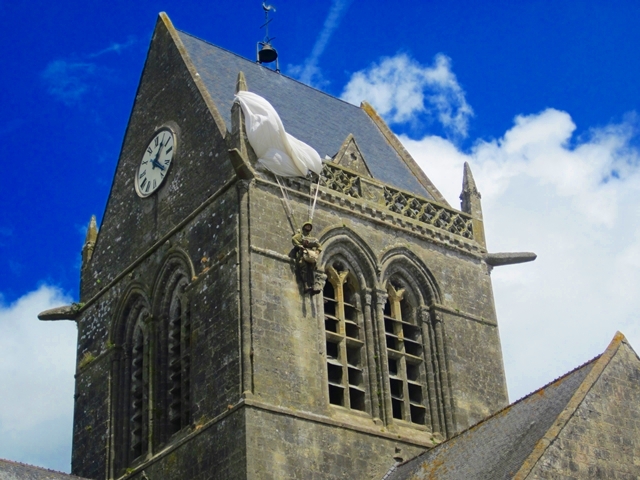 During 1944 there were frequent allied air raids on the town and the night of June 5th – 6th was no different. A house in the square caught fire, At this point parachutes were seen in the night sky and began landing in and around the town. It was the 82nd airborne division.
During 1944 there were frequent allied air raids on the town and the night of June 5th – 6th was no different. A house in the square caught fire, At this point parachutes were seen in the night sky and began landing in and around the town. It was the 82nd airborne division.
The Germans opened fire and ordered the locals into their houses. The Austrians left and only a few Germans continued the fight. The town was taken by members of the 505th. At 04:30 the stars and stripes were hoisted over the town and St Mere Eglise was the first town to be liberated in France. The town was made famous by the paratrooper John Steel and by the film “The Longest Day”.
John Steel managed to land on the church and his chute caught on the steeple. He hung there while the fighting continued on the ground for two hours before being cut down by the Germans, taken prisoner and later released by the Americans. An effigy of John Steel is usually to be seen on the church.
Above is the church and the effigy – today:
 The inside of he church and stained glass windows are beautiful!
The inside of he church and stained glass windows are beautiful!
 St Michael is surrounded with emblems of the many military units involved with the liberation of Normandy. Note the Parachute at the top.
St Michael is surrounded with emblems of the many military units involved with the liberation of Normandy. Note the Parachute at the top.
That’s it for our trip through the WWII beaches in Normandy. There are more pictures and more history, but it’s time to move on to Mont St Michele.

